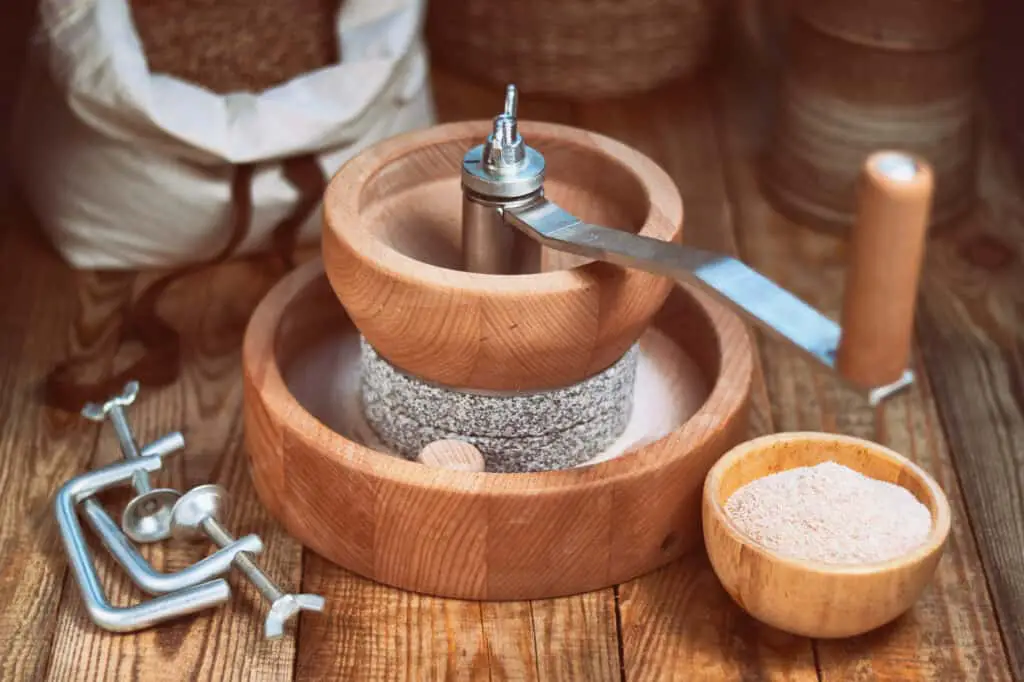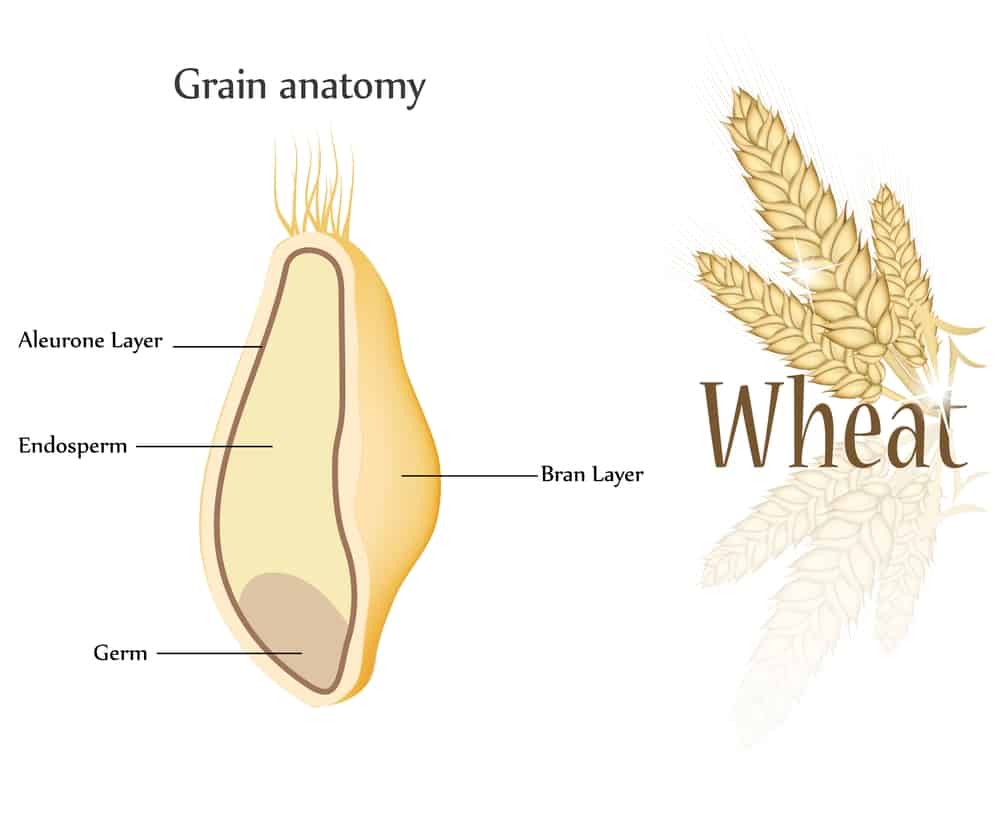For quite some time now, what most Americans have been eating when it comes to bread is a really refined, fast-processed bread that strips some key nutrients. In recent years, a movement has emerged that seeks to use freshly milled flour that is not stripped of its nutrients. The freshly milled flour movement seeks to restore the vital nutrients and essential nutritional components that bread once had before mass consumption took over.
Milling fresh flour is a process that seeks to maintain the bran and the germ of a grain during a rapid and largely unprocessed grinding maneuver. Freshly milled flour is essentially 100% whole grains that have been grinded into flour to then use for baking.
In this guide, we are going to take an in-depth look at the freshly milled flour movement that emerged in 2016. We will look at the process behind making fresh milled flour, in addition to providing tips on where to buy this variety of flour and its nutritional benefits. We will also look at the shelf life of fresh milled flour and offer some important tips when it comes to baking with this relatively new style of flour.
Fresh Milled Flour
Simply put, freshly milled flour is a type of flour in its purest state with the nutrients intact. Commercial mills remove 30 percent of the wheat kernel, removing the most nutritious part of the grain to make white flour. Milling your own flour or purchasing fresh milled flour not only ensures that your flour is as nutritious as it can be, but it also has a wonderful taste that is lost to commercially made whole-grain flour.
Whole grain flour contains more nutrients, vitamins, and fiber than white flour. Whole grain contains the entire grain kernel which includes a portion of the bran, germ, and endosperm. The bran is the hard outer covering that surrounds the inner germ and endosperm. The germ is an embryonic seed and contains unsaturated oils.
The endosperm is the largest part of the kernel, which is mostly starch. The bran and germ contain a number of nutrients that are not found in processed white flours.
These include vitamin E, folate, fiber, and antioxidants. The nutrients in whole grain flour come from the bran and germ. The nutrients are lost when these parts of the kernel are refined out of whole-grain flour. In addition, the high starch content of white flours increases the absorption of fat so more is stored in the body as compared to eating whole grains.
Whole grains also have a lower glycemic index than processed grains and result in fewer blood sugar spikes and longer satiety that lowers appetite. White flour has been stripped of nearly everything that’s good for you because of the way it was processed.
One of the most frequently asked questions out there about freshly milled flour is “why does whole-grain flour make such better-tasting baked goods?”.
Many bakers are choosing to switch to freshly milled flour for their baking and often swear by the results of using freshly milled flour because their breads and baked goods made from freshly milled flour have better flavor and texture.
Freshly ground flour is alive, having its enzymes, nutrients, and fiber. Fiber provides structure and texture. The bran and germ add flavor and even a bit of sweet taste. You want as much of those vitamins, minerals, and fiber as possible to be passed on to the final product which will help make up for any missing ingredients.
Freshly milled flour is what you need if you want a baked good with a greater depth of flavor. By using fresh flour you will get a creamier texture, more body, and better flavor.
What Makes It Different?

Milling your own flour is one way to guarantee that you are getting exactly what you need in your food. There are many additives or preservatives that can come into the supply chain of food processing facilities and middlemen. This can have a devastating outcome on those who have allergies to certain products. Having freshly milled flour is not only an assurance of freshness but also an assurance that unknown ingredients will not be present in your flour.
The truth is, even if you buy from a bakery, they have to have their flour delivered every 4-6 weeks. In between, it’s been sitting in a warehouse somewhere and is probably around a year old. Milling your own flour at home is an inexpensive way to ensure you are getting fresh pure flour. Fresh flour can be milled just before using, so no time is lost. This also ensures the germ of the wheat berry hasn’t been damaged during storage, preserving your flour’s nutritional value.
When you look at the rising costs of groceries, it’s clear that milling your own flour just makes sense. You can save money on your grocery bill by grinding your own wheat, corn, rice, etc into flour at the fraction of the price of store-bought flour. In addition to saving money, you can save it from spoiling longer by storing whole grains in airtight containers.
If you’re not familiar with emergency preparedness, it can cost hundreds of dollars to set up a dedicated emergency food storage containing the right amount of food and water. To avoid panic-buying these items at your local store (during the only hours that they’re actually open) a great thing to do is to prepare yourself for an emergency for half the price.
One way to do that is by storing grains and legumes instead of flour and rice. You can save a great deal of cost while still preparing edible meals with food storage that lasts longer.
Fresh Flour Mills
There are now many different fresh grained flour mills to choose from and the process for making freshly milled flour is fairly straightforward. In traditional milling, wheat of different grades and moistures is blended together to obtain a batch of wheat with the characteristics necessary to make the kind of flour being manufactured.
At this point, the wheat may be processed in an Entoleter, a trade name for a device with rapidly spinning disks which hurl the grains of wheat against small metal pins. Those grains which crack are considered to be unsuitable for grinding and are removed, and this is still used for fresh milled flour.
The wheat moves between two large metal rollers known as breaker rolls. These rollers are of two different sizes and move at different speeds. But unlike in the traditional process for flour milling, the process for freshly milled flour does not split the grains to remove the bran and germ–these two essential nutrients are left fully intact.
Middlings are ground into flour by pairs of large, smooth metal rollers. Each time the flour is ground it passes through sieves to separate it into flours of different fineness. These sieves are made of metal wire when the flour is coarse, but are made of nylon or silk when the flour is fine. By sifting, separating, and regrinding the flour, several different grades of flour are produced at the same time. These are combined as needed to produce the desired final products.
With freshly milled flour, the final product in the milling stage contains virtually all of the grain intact that is then grinded into a fine flour. Essentially, this is tantamount to allowing the entire grain to be ground and then concentrated into the final form which is flour. Many of the processes of traditional flour milling are excluded, and this also makes the process for creating freshly milled flour move much more quickly.
Where To Buy Freshly Milled Flour
There are so many benefits to using flour that is freshly milled, with the most important being the flavor and aromatics. If you mill at home, you’ll know exactly what I am talking about; with noticeable flavor differences in your baked goods. I recently grinded my own flour, and the taste and smell was out of this world.
But in the grand scheme of things, milling to order helps us to reduce food waste. From week to week, many customer orders can fluctuate and freshly milled flour companies with online ordering are able to mill and briefly store what is needed without sitting on stockpiles of aging flour. What many retailers mill in a given week is either delivered or shipped within a day or two of milling.
While this might not be the most time efficient way to mill, the end product is exactly what many customers seeking freshly milled flour want, flour that has been transformed from a basic ingredient to the star of whatever dish you’re baking.
Benefits

As previously mentioned, when grains are ready for milling, there are 3 basic parts to know about: the bran, the germ, and the endosperm. The bran is high in fiber, has a good amount of proteins, and enzymes that help with digestion. The germ is the smallest part of the kernel, but it contains the highest density of nutrients—mostly fatty acids and a lot of vitamin E.
The endosperm is the largest part of the kernel, it’s primarily starch and serves as the food for the plant—this is the only part you get with commercial white flour.
Compare that to stone-ground flour, which crushes the whole grain kernel—the bran, the germ, and the endosperm—releasing all of the nutritious vitamins, minerals, and oils into the flour. This is more complete and as nature designed it—a whole food. You can use that flour as is (whole grain flour), or you can sift out some of the bran (high-extraction or ‘bolted’ flour) to varying degrees, which is somewhere between a whole grain flour and a white flour.
The beauty of freshly stone-milled flour is that even if some of the bran is sifted out for a high-extraction flour, the oils of the germ have still been rubbed into the white, starchy portion of the flour, resulting in a relatively more flavorful and nutritious “whitish” flour, that still performs well and tastes delicious.
Health Benefits Of Fresh Milled Flour
The quality of your flour depends on several different things, including the milling process, the conditions the grain grows in and the size of the production. When flour is produced on a mass scale, it loses the majority of the grain’s naturally-occurring vitamins, nutrients, minerals, and antioxidants, thanks to processing.
Most of the nutrition in grain is found in the bran and germ of the kernel. But commercial flours remove the bran and germ because without the oils that those parts contain, the flour lasts longer on the shelves. The grain kernel contains over 30 nutrients, and most of them are removed during the commercial milling process.
Even if you buy “enriched” flour, you are only getting a fraction of the nutrition that is readily available in the whole grain. This is what makes freshly milled flour such a great alternative to consider.
Fresh Milled vs Store Bought Flour
Freshly milled flour is completely different from the homogenous commodity product that we have become accustomed to. For one thing, industrially produced white flour is stripped of most micronutrients during the milling and bleaching process, so it is federally required to have B vitamins and iron added back into it since these nutrients are often lacking in American diets.
The nutrients are removed along with most of the fiber in the bran and germ of the wheat kernel, leaving only the starchy endosperm in the finished product. This benefits producers because it extends the shelf life of the flour; along with fiber, protein and minerals, the bran and germ also contain oils that can easily go rancid.
Fresh flour has a subtly sweet, nutty scent and silky texture, I had never imagined flour could have so much character. It bakes up beautifully, adding an extra layer of flavor and crumb to anything you make. Locally sourced, freshly milled whole wheat flour does not need to be enriched because it never gets stripped and bleached of nutrients.
It does need to be treated with more care, however, iIf you are not able to use it within a few weeks, I recommend storing it in the freezer to retain nutrients and flavor.
Fresh flour may cost more than the processed stuff, but it has a whole lot more to offer in terms of taste and nutrition. For me, baking with freshly milled, locally grown flour connects me to a time before our food system was industrialized and I appreciate the farmland and the people who work it just a little bit more.
Baking With Fresh Milled Flour
Conventional flours are often made from a blend of wheat varieties in order to produce a consistent product year after year. Through a series of siftings, conventional bread flour is transformed from a wholesome, texture-rich flour to a muted white powder. Stretching and folding, as opposed to kneading, is a gentler and less messy way of developing gluten while simultaneously coaxing out flavor through a lengthy fermentation.
Using wet hands to prevent sticking, stretch a portion of the dough almost to the point of tearing and then fold it over the remaining dough. With each turn, the dough will become progressively more extensible (stretchy). Pre-shaping the dough builds structure for the final loaf. In as few movements as possible, pull the dough across a clean, floured work surface to form a rounded ball.
Using a bench scraper as an extension of your hand, slide the dough with smooth and assertive motions. Overlapping folds develop tension without degassing the dough. Gently stretch the dough to the side about 6-inches and then fold it up and over the previous folds to form a neat package. Incorporate as little flour as possible to ensure the seams stick to one another and that no pockets of raw flour are baked into the final loaf.
The crosshatch fold further develops the necessary tension for a robust oven spring (the rapid expansion of volume the loaf undergoes during the first part of the bake). Pull a small portion of dough on either side of the loaf across at a diagonal; press lightly to secure. Repeat to form 3 crosshatches – top, middle and bottom of the loaf. If you choose, stenciling is purely decorative. It can be used as a baker’s “signature” or to distinguish between types of breads.
Dusting the design in white rice flour provides a distinct contrast against the golden baked loaf. I did this recently and not only was it fun, but it also really made the bread stand out.Rice flour also has a high heat tolerance making it unlikely to scorch.Scoring allows the bread to fully expand while baking. Hold the lame at a 45° angle with the blade pointed toward the center of the loaf, and slice the dough, about 1/4-inch deep, using the corner edge of the blade.
Then, you will want to use decisive and swift movements to prevent dragging the dough and creating jagged tears. Breads made with freshly milled flours contain more residual sugars after fermentation due to the abundance of nutrients in the grain. When exposed to dry heat, the sugars on the surface of the loaf become deeply caramelized and release a toasty sweet aroma.
For a well-developed crust, bake the bread to a rich mahogany color. High hydration breads typically have an open crumb (top), but fragments of bran and germ found in freshly milled flours disrupt gluten development contributing to a tighter crumb. Use a bread knife with scalloped edges and rounded teeth to saw through the crust and prevent tearing the loaf.
You now have freshly milled bread.
Fresh Milled Flour Shelf Life

Fresh flour usually contains the naturally occurring oils found in wheat, which makes it less shelf-stable than all-purpose flour. At many different freshly milled flour companies, the in-store bakers use their fresh flour within 24 hours, but they recommend customers store its 1 kilogram to-go zip-top bags in the fridge and use it within a week.
If you’re unsure about how to store your flour, ask when you buy it. But many small mills advise you to keep it in your fridge or freezer. You’ll know your flour has gone bad if it smells and tastes stale or rancid.
How To Store Fresh Milled Flour
Buying organic, whole grain bread is expensive. So is buying the grains to make your own. But even including the expense of purchasing an electric mill, you can expect to spend approximately 25-50 cents per loaf of bread when you are milling flour in your home. And that’s just for bread. If you eat a few loaves of bread each week, you can easily pay for your mill in the first year.
If you are concerned about the waste that could be caused by using whole grain to mill flour, don’t be. If you keep your milled flour in a cool place, it will last a week or more. Many people like to keep only a small amount of milled flour stored for use in various recipes. It is ideal to use freshly milled flour within 30 -40 days because it is fresh. After 30-40 days it begins to lose the fresh milled flavor due to oxidation.
However, as long as it is stored in a dry cool place it will not lose nutrition or go “bad” for up to 6 months. It is not recommended that you store fresh milled flour in the freezer. Fresh millers go to great lengths to clean and mill grains each week so that you can enjoy the fresh milled flavor. If you put fresh milled flour in the freezer it sucks out the moisture and leaves an off flavor.
If you live in a humid environment it is recommended that you store whole grains (that are not going to be consumed within a few months) in the refrigerator or freezer. Whole grains have their own natural storage capsule; as long as they are not cracked open and exposed to air (oxidation) they will remain viable whole grains (seeds) for years and be perfectly edible.
